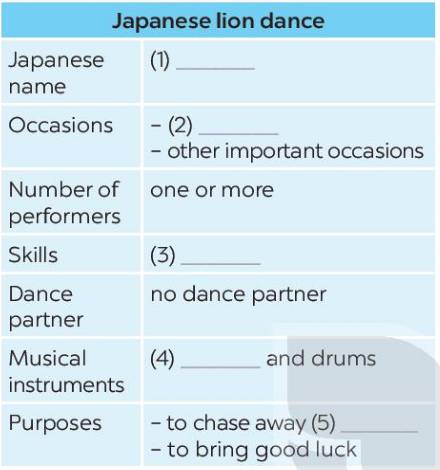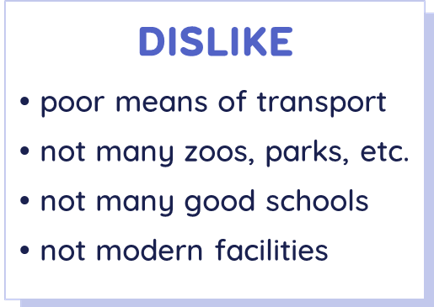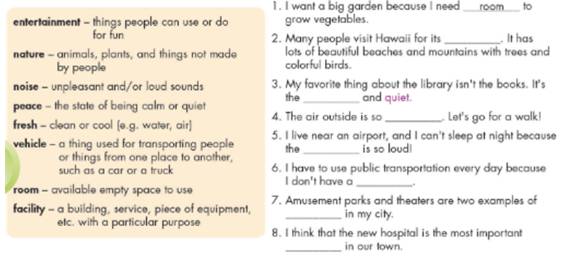Hãy nhập câu hỏi của bạn vào đây, nếu là tài khoản VIP, bạn sẽ được ưu tiên trả lời.

Japanese lion dance (Múa sư tử ở Nhật) | |
Japanese name (Tên tiếng Nhật) | (1) shishi-mai |
Occasions (Dịp) | (2) New Year celebration (chào mừng năm mới) other important occasions (những dịp quan trọng khác) |
Number of performers (Số người biểu diễn) | one or more (một hoặc nhiều người) |
Skills (Những kĩ năng) | (3) controls the lion's head and moves the lion's body (điều khiển đầu con sư tử và di chuyển thân sư tử) |
Dance partner (Người nhảy chung) | no dance partner (không có người nhảy chung) |
Musical instruments (Nhạc cụ) | (4) flutes and drums (sáo và trống) |
Purposes (Mục đích) | to chase away (5) bad spirit (xua đuổi tà ma) to bring good luck (đem lại may mắn) |

Part 1. Read the passage and Decide if the statements are true (T) or false (F).. (1.0pt)
The dragon dance and the lion dance was originated from China, and it has been introduced to many parts of the world. The dragon dance and lion dance are also popular in some traditional festivals in Vietnam. Dragons symbolize wisdom, power and wealth, and they are believed to bring good luck to people. The origin of the dragon dance can be dated back to the Han Dynasty (206 BC–220 AD). It was then used in a ceremony for worshiping ancestors and praying for rain, and it gradually developed into an entertainment activity. By the Tang Dynasty (618–907) and the Song Dynasty (960–1279), it had become a common ceremonial activity in festivals like Chinese New Year.
1. The dragon dance came from China.
2. People think that the dragon dance is associated with luck.
3. The dragon dance was firstly performed for entertainment.
4. People performed the dragon dance to pray for less rain.
T - T - F - F
Part 2. Read the text and then choose the correct answer A, B, C or D. (1.5p)
Among the very old days of the country, (1) …………… the government of King An Duong Vuong
(Thuc Phan), Vietnam was called Au Lac. The King decided to build Co Loa as the country’s royal
(2) ……………… To (3) ………...… the event when An Duong Vuong started moving into the citadel, residents of 12 hamlets belonging to Co Loa as well as 7 other communes around the region held Co Loa Citadel Festival within a 10 day period - from the 6th to 16th day of the first Lunar month.
On the 5th day, in the afternoon, all of the eight communes (4) ……………… a ceremony with incense offering at the (5) …………… house. Meanwhile, at An Duong Vuong Temple, the same ritual is held by the most (6) …………… elder among 8 communes, with revision of An Duong Vuong’s accomplishments and merits.
1. A. in B. over C. under D. on
2. A. castle B. kingdom C. palace D. house
3. A. memorize B. miss C. remind D. commemorate
4. A. hold B. is held C. take place D. takes place
5. A. commune B. communal C. common D. commonly
6. A. respected B. disrespected C. respectful D. disrespectful
VI. DO AS DIRECTED (3p)
1. We/ together/ on/ have/ dinner/ a/ family/ of/ eating/ New Year’s Eve/ tradition.
(Reorder this sentence)
è …………We have a tradition of eating dinner together on New Year's Eve
……………………………………………………………………………………………
2. . It’s good for us to keep our traditional customs. (Rewrite sentence with SHOULD)
è …………We should keep our traditional customs.
……………………………………………………………………………………………
3. Sebastien is a French, but he plays Vietnamese folk games well.
(Rewrite sentence with ALTHOUGH)
è ………………Although Sebastien is a French, he plays Vietnamese folk games well.
………………………………………………………………………………………
4. while/ elephants/ race/ people/ cheer/ encourage/ them
(Make sentences, using the words or phrases provided. You can add some words or make changes)
…………While the elephants were racing, people cheered to encourage them.
……………………………………………………………………………………………

The dragon dance and the lion dance originated from China, and it has been introduced to many parts of the world. The dragon dance and lion dance are also popular in some traditional festivals in Vietnam. Dragons symbolize wisdom, power and wealth, and they are believed to bring good luck to people. The origin of the dragon dance can be dated back to the Han Dynasty(206 BC-220 AD). It was used in a ceremony for worshiping ancestors and praying for rain, and it gradually developed into an entertainment activity. By the Tang Dynasty (618-907) and the Song Dynasty(1960-1279), it had become a common ceremonial activity in festivals like CHinese New Year.
The dragon body is woven in a round shape of thin bamboo strips, segment-by-segment, and covered with a huge red cloth with dragon scalees decorating it. The whole dragon is usually up to the 30 meters in length - and people hold rods every 1 to 2 meters to raise the dragon segments.
26.The dragon dance came from China. T
27.People think that the dragon dance is associated with luck. T
28.The dragon dance was firstly performent for entertainment. T
29.People performed the dragon dance to pray for less rain. F
30.The whole dragon is usually much more than 30 meters in high.F

❤Read the text about and decide if the statements are true(T) or false(F)
The dragon dance and the lion dance originated from China, and it has been introduced to many parts of the world. The dragon dance and lion dance are also popular in some traditional festivals in Vietnam. Dragons symbolize wisdom, power and wealth, and they are believed to bring good luck to people. The origin of the dragon dance can be dated back to the Han Dynasty(206 BC-220 AD). It was used in a ceremony for worshiping ancestors and praying for rain, and it gradually developed into an entertainment activity. By the Tang Dynasty (618-907) and the Song Dynasty(1960-1279), it had become a common ceremonial activity in festivals like CHinese New Year.
The dragon body is woven in a round shape of thin bamboo strips, segment-by-segment, and covered with a huge red cloth with dragon scalees decorating it. The whole dragon is usually up to the 30 meters in length - and people hold rods every 1 to 2 meters to raise the dragon segments.
☘1.The dragon dance came from China. T
2.People think that the dragon dance is associated with luck. T
3.The dragon dance was firstly performent for entertainment. T
4.People performed the dragon dance to pray for less rain. F
5.The whole dragon is usually much more than 30 meters in high.F

Tại vì đây là một câu passive (câu bị động)
Trong trường hợp này, câu có nghĩa là "Nó đc biểu diễn..." chứ ko phải "Nó biểu diễn..."
(mình ko giỏi về mấy dụ giải thích nhưng mong bạn hiểu đc =))))

The Obon dance is a traditional Japanese dance. People have the honour of their ancestors. The Obon festival takes place in mid-August in many regions of Japan and in mid-July in other regions. There are many forms in different regions. The most typical form is circle dance. People make a circle around a yagura, a high wooden stage; some dancers move clockwise, and some counter-clockwise. This is one of the most important traditions. A lot of people come back to reunite with their families during the Obon festival.

Living in the countryside is very unique. Although many people think that the country is not good or not well-provided, it's still one of the best options for healthy living. In the countryside, first, it's the low cost of living. Secondly, unlike the cities, the country provides fresh air and green spaces. Last but not least, the villagers are always kind and friendly, willing to help each other no matter what.
Some people really prefer to live in the downtown because of its facilities. But I prefer to live in the countryside because of many reasons.
First of all, the life in the city makes me uncomfortable, I cannot bear to live in cramped conditions with the hustles and bustles. We do not have fresh air to breathe, do not have a space for our children to play and for us to relax. It is really tiring and upset to wait for hours because of traffic jams.
Secondly, the pollution because of smogs and dusts and noise can make me feel sick. Moreover, I do not feel safe to live in the city because the criminal situations are rising. , We feel worried when we go out each time.
Thirdly, Nowadays, the conditions of the countryside are better and better, the gap between the cities and the countryside is narrowed day by day.
I love the silence, I love fresh air. I love the good relationships of people. so I love to live in countryside.

Đáp án:
1. room | 2. nature | 3. peace | 4. fresh |
5. fresh | 6. vehicle | 7. entertainment | 8. facility |
Hướng dẫn dịch:
giải trí - những thứ mọi người có thể làm để vui vẻ
tự nhiên - động vật, thực vật và những thứ không làm ra từ con người
tiếng ồn - âm thanh khó chịu hoặc lớn
bình yên - trạng thái bình tính hoặc lặng yên
tươi - sạch hoặc mát (ví dụ: nước, không khí)
xe cộ - một thứ được sử dụng để vận chuyển người hoặc vật từ nơi này sang nơi khác, chẳng hạn như ô tô hoặc xe tải
phòng - có sẵn không gian trống để sử dụng
trang thiết bị - một tòa nhà, dịch vụ, thiết bị, v.v. với một mục đích cụ thể
1. Tôi muốn có một khu vườn lớn vì tôi cần chỗ để trồng rau.
2. Nhiều người đến thăm Hawaii vì tự nhiên của nó. Nó có rất nhiều bãi biển và núi đẹp với cây cối và các loài chim đầy màu sắc.
3. Điều tôi thích nhất về thư viện không phải là sách. Đó là yên bình và yên tĩnh.
4. Không khí bên ngoài thật trong lành. Chúng ta hãy đi dạo!
5. Tôi sống gần sân bay, và tôi không thể ngủ vào ban đêm vì tiếng ồn quá lớn!
6. Tôi phải sử dụng phương tiện giao thông công cộng hàng ngày vì tôi không có phương tiện đi lại.
7. Công viên giải trí và nhà hát là hai ví dụ về giải trí trong thành phố của tôi.
8. Tôi nghĩ rằng bệnh viện mới là cơ sở quan trọng nhất trong thị trấn của chúng tôi.





Similarities: (Điểm giống nhau)
- both popular in New Year celebration and other important occasions like business opening and wedding ceremony. Especially, unicorn dance is also performed in Mid-Autumn Festival.
(đều phổ biến vào dịp mừng năm mới hoặc các sự kiện quan trọng khác như khai trường và đáp cưới. Đặc biệt còn có múa lân vào dịp Trung thu.)
- one or many performers take part in the dance.
(một hay nhiều người cùng tham gia múa.)
Difference: (Sự khác nhau)
Japanese lion dance
(Múa sư tử Nhật Bản)
Vietnamese unicorn dance
(Múa lân Việt Nam)
Japanese name
(Tên tiếng Nhật)
shishi-mai
Mua lan (Múa lân)
Skills
(Kỹ năng)
controls the lion's head and moves the lion's body
(điều khiển đầu con sư tử và di chuyển thân sư tử)
Martial arts and acrobatics
(Võ thuật và nhào lộn)
Dance partner
(Người múa cùng)
no dance partner
(không có người nhảy chung)
Ong Dia
(Ông Địa)
Musical instruments
(Nhạc cụ)
flutes and drums
(sáo và trống)
drum
(trống)
Purposes
(Mục đích)
to chase away bad spirit (xua đuổi tà ma)
to bring good luck (đem lại may mắn)
to wish for luck and success
(mong ước may mắn và thành công)